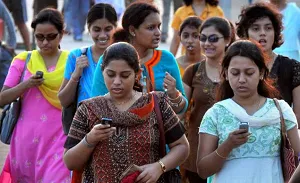Indian women are 28 pc less likely than men to own a mobile phone: GSMA
This represents one of the widest mobile gender gaps in the world even at a time when India is in the middle of a smartphone and mobile internet revolution.
As in all walks of life, there is a gender gap - a wide one at that - in mobile ownership too, especially in India.
A GSMA study titled Connected Women 2019 Gender Gap Report indicates that Indian women are 28 percent less likely than men to own a mobile phone, and 56 percent less likely to use mobile internet. This represents one of the widest mobile gender gaps in the world even at a time when the country is in the middle of a smartphone and mobile internet revolution.
Further, only 59 percent of Indian women own a mobile phone, compared to 80 percent average ownership in other low-and middle-income countries. And only 42 percent of them are aware of the mobile internet, GSMA states. (In 2017, this awareness was even lower at 17 percent.)
Mats Granryd, Director General, GSMA, said,
“While mobile connectivity is spreading quickly, it is not spreading equally. Unequal access to mobile technology threatens to exacerbate the inequalities women already experience... In an increasingly connected world, women are still being left behind.”

India’s top telcos are, however, are keen to correct this. The likes of Vodafone-Idea and Bharti Airtel have joined the GSMA Connected Women Programme’s Commitment Initiative that attempts to bridge the gender gap in mobile connectivity by 2020.
The initiative, which has signed up over 37 mobile operators from 27 countries across Africa, Asia and Latin America, plans to actively drive digital and financial inclusion for millions of women.
Also Read: India's internet population is growing older and more rural: InMobi
Now, what ails mobile ownership among women?
Literacy and skills emerged as the top barrier for women in their use of mobile internet. Affordability, a perceived lack of relevance, safety and security are other issues plaguing mobile ownership among women.
Despite the fact that over 250 million more women across low-and-middle-income economies became mobile owners since 2014, there are close to 432 million women who are still unconnected. And, it will require “concerted effort and coordination from the mobile industry as well as policy makers and the international community” to bring them online.
By closing the gender gap, an estimated $140 billion could be added to the mobile industry by 2023, GSMA stated. “Ensuring digital and financial inclusion for women is critically important, as we know that when women thrive, societies, businesses and economies thrive,” Granryd added.







